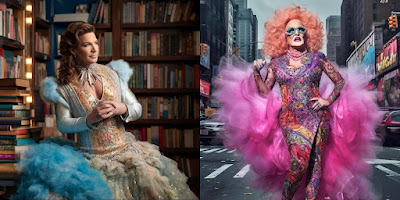There was a show on CNN last year called Stanley Tucci: Searching
for Italy that featured many of my loves, from food and cooking, to travel
and history, to the adorable Stanley Tucci. Well, this year they are doing Eva
Longoria: Searching for Mexico, and again it features food and travel and history,
though, sadly, without The Tooch.
On a recent episode, Longoria was in Oaxaca cooking with the
Indigenous Zapotec people, and she was introduced to an extremely interesting
subset of people, the Muxe—pronounced moo-shay. As legend has it, San
Vicente Ferrer, the patron saint of Juchitán, was carrying three bags of seeds
meant to be distributed around the world. The first contained male seeds, the
second contained female seeds and a third bag contained a mixture of the two,
and as San Vicente was passing through Juchitán, the third bag ruptured and
from that arose the town’s famed
community of Muxes. The Zapotec people often refer to Muxes as a third gender;
they embody the characteristics of both men and women, but as Felina Santiago,
a Muxe featured in the episode says:
“We are people of two spirits. We are the duality, neither
man nor woman. You are neither less nor more.”
Muxes
are generally assigned male at birth but tend to present in typically feminine
ways through their behaviors, brightly colored clothing and makeup, flowers in
their hair and chosen occupations. Many are skilled in embroidery or other
artisan crafts, or work as merchants in the markets that drive the region’s
economy; often they are the caretakers for the elderly in their community. And
yet other Muxes are teachers, lawyers and social justice activists who wear
masculine clothing at work but don the more feminine attire in their private
lives.
But Muxes aren’t defined by their appearance, nor are they
labeled with being transgender, a more Westernized, almost simplistic description.
Muxes are not male and they are not female; they are the duality of gender. Most
Muxes are attracted to heterosexual men, though many do not label themselves as
gay but see themselves as a social and gender category rather than a sexual orientation
classification. Even the Zapotec language is accommodating to the Muxe as it has
no grammatical gender, only one form for all people. And while the older generations
of Muxe don’t experience gender dysphoria, the younger generation is more open
to hormone therapies.
One thing all Muxes are is proud of their Zapotec heritage, and
they play a key role in preserving Zapotec culture, upholding culinary
traditions and other ancient rituals. And as the keepers of their history and
society, Muxes enjoy a level of respect and acceptance in the Zapotec community.
Some think having a Muxe in the family is a blessing, because of how Muxes tend
to nurture the young and care for the elderly.
Still, life is not all easy for Muxes, especially in a Latin
country with a distinct patriarchy and a high level of machismo. Many are
forced to leave home by their fathers if the father becomes aware the child is
Muxe, seeing it as a mark against the family, but many more times the women in
the household override the male machismo and allow their child to remain and
stay part of the family; they say women choose their children over their men
any day.
And they are becoming more well-known, more outspoken, and
more accepted by the outside community; every November Muxes in Juchitán put on
a festival, “La Vela de Las Auténticas Intrépidas Buscadoras del Peligro,” or
“The Vigil of the Authentic, Intrepid Danger-Seekers.” The festival began in 1976
in response to the persecution Muxes faced, and the celebration draws crowds
from all over the world, with a parade of colorful floats, a Catholic mass and
dancing, and a catwalk show that culminates in the crowning of a queen.
“La Vela de Las Auténticas Intrépidas Buscadoras del Peligro”
is a way for Muxes to assert themselves, to come out so to speak, in a space
that’s their own. And every year Muxes and non-Muxes alike join the
celebration, embracing Muxes and their culture. But their lives are not all fancy
dresses and flowers and a once-a-year celebration, for they still struggle for
recognition while the debate about what it means to be Muxe, and whether
their identity is inherent at birth or shaped by society, whether Muxes must be
of Zapotec ancestry, and whether undergoing gender reassignment therapies
changes the calculus.
But what I learned most about watching the episode, and then
reading about Muxes, is their joy; their passion for their lives, their beauty,
their desire to care for others that may have been forgotten by their own
families. I thought about all of the anti-transgender hatred, and the anti-drag
laws in this so-called modern society, and
then look at Muxes who have been in existence for hundreds and hundreds
of years, and most of the time, aren’t given a second thought.
They are just Muxes, reminding the rest of us that literally
since time began there has been no single way to express gender identity. And
if this ancient community can understand that, even as some struggle with the
idea, why can’t the rest of the world, especially in this country?
Sidenote: and this isn’t the only community like this that
has been around for centuries. I also learned from Drag Race … sheesh, who knew
a cooking show and a drag show could be so educational … and Sasha Colby that in
Hawaiian culture, Mahu refers to someone with a male and female spirit and
a mixture of gender traits.
This is nothing new people, so why are some of us so
frightened by it? |





















































